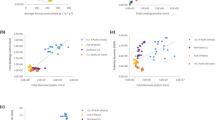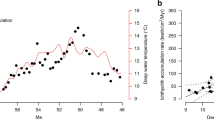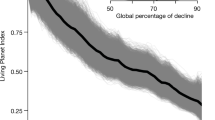Abstract
THE mean of reported annual world fisheries catches for 1988-1991 (94.3 million t) was split into 39 species groups, to which fractional trophic levels, ranging from 1.0 (edible algae) to 4.2 (tunas), were assigned, based on 48 published trophic models, providing a global coverage of six major aquatic ecosystem types. The primary production required to sustain each group of species was then computed based on a mean energy transfer efficiency between trophic levels of 10%, a value that was reestimated rather than assumed. The primary production required to sustain the reported catches, plus 27 million t of discarded bycatch, amounted to 8.0% of global aquatic primary production, nearly four times the previous estimate. By ecosystem type, the requirements were only 2% for open ocean systems, but ranged from 24 to 35% in fresh water, upwelling and shelf systems, justifying current concerns for sustainability and biodiversity.
This is a preview of subscription content, access via your institution
Access options
Subscribe to this journal
Receive 51 print issues and online access
$199.00 per year
only $3.90 per issue
Buy this article
- Purchase on Springer Link
- Instant access to full article PDF
Prices may be subject to local taxes which are calculated during checkout
Similar content being viewed by others
References
Vitousek, P. M., Ehrlich, P. R., Enrlich, A. H. & Matson, P. A. Bioscience 36, 368–373 (1986).
Gulland, J. A. (ed.) The Fish Resources of the Oceans (Fishing News Books, West Byfleet, UK, 1971).
FAO FAO Year book 72, 113–120 (1993).
Alverson, D. L., Freeberg, M. H., Murawski, S. A. & Pope, J. G. FAO Tech. Pap. 339 (1994).
Roger, C. Envir. Biol. Fishes 39, 161–172 (1994).
May, R. M., Beddington, J. R., Clark, C. W., Holt, S. J. & Laws, R. M. Science 203, 267–277 (1979).
Pauly, D. in Ocean Yearbook 6 (eds Borgese, E. M. & Ginsburg, N.) 29–37 (Univ. Chicago Press, Chicago, 1986).
Li, W. K. W. et al. Science 219, 292–295 (1983).
Post, W. M. et al. in The Science of Global Change (eds Dunnette, D. A. & O'Brien, R. J.) 392–412 (Am. Chem. Soc. Symp. Ser. Washington DC, 1992).
McClatchie, S. Continental Shelf Res. 8, 329–345 (1988).
Christensen, V. & Pauly, D. Ecol. Modelling 61, 169–185 (1992).
Strathmann, R. R. Limnol. Oceanogr. 12, 411–418 (1967).
Lieth, H. in Patterns of Primary Production in the Biosphere. (ed Lieth, H. F.) 277–282 (Dowden, Hutchinson & Ross, Stroudsburg, Pennsylvania, 1978).
Crossland, C. J., Hatcher, B. G. & Smith, S. V. Coral Reefs 10, 55–64 (1991).
De Vooys, G. G. N. in The Global Carbon Cycle (eds Bolin, B., Degens, E. T., Kempe, S. & Ketner, P.) 259–292 (Wiley, New York, 1979).
Jarre-Teichmann, A. & Christensen, V. International Centre for Living Aquatic Resources Management Studies and Reviews 24 (in the press).
Cushing, D. H. in Penaeid Shrimps: their Biology and Management (eds Gulland, J. & Rothschild, B.) 254–258 (Fishing News Books, Farnham, Surrey, England, 1984).
Kolding, J. in Trophic Models of Aquatic Ecosystems (eds Christensen, V. & Pauly, D.) 116–123 (International for Living Aquatic Resources Management, Manila, 1993).
Cousins, S. New Scient. 4, 50–54 (1985).
Christensen, V. & Pauly, D. (eds) in Trophic Models of Aquatic Ecosystems 338–352 (International Center for Living Aquatic Resources Management, Manila, 1993).
Christensen, V. International Council for the Exploration of the Sea, Council Meeting/L:25 (1992).
Christensen, V. & Pauly, D. (eds) Trophic Models of Aquatic Ecosystems (International Center for Living Aquatic Resources Management, Manila, 1993).
Pauly, D. & Christensen, V. in Large Marine Ecosystems: Stress, Mitigation and Sustainability (eds Sherman, K., Alexander, L. M. & Gold, B. D.) 148–174 (American Association for the Advancement of Science, Washington DC, 1993).
May, R. M. in Theoretical Ecology: Principles and Applications (ed. May, R. H.) 142–162 (Blackwell Scientific, Oxford, 1976).
Author information
Authors and Affiliations
Rights and permissions
About this article
Cite this article
Pauly, D., Christensen, V. Primary production required to sustain global fisheries. Nature 374, 255–257 (1995). https://doi.org/10.1038/374255a0
Received:
Accepted:
Issue Date:
DOI: https://doi.org/10.1038/374255a0
This article is cited by
-
Effect of trade on global aquatic food consumption patterns
Nature Communications (2024)
-
The Pelagic Species Trait Database, an open data resource to support trait-based ocean research
Scientific Data (2024)
-
Satellite observations of coastal upwelling in the northern Arafura Sea
Journal of Oceanology and Limnology (2024)
-
Geostrophic flows control future changes of oceanic eastern boundary upwelling
Nature Climate Change (2023)
-
Carbon sequestration by multiple biological pump pathways in a coastal upwelling biome
Nature Communications (2023)
Comments
By submitting a comment you agree to abide by our Terms and Community Guidelines. If you find something abusive or that does not comply with our terms or guidelines please flag it as inappropriate.



